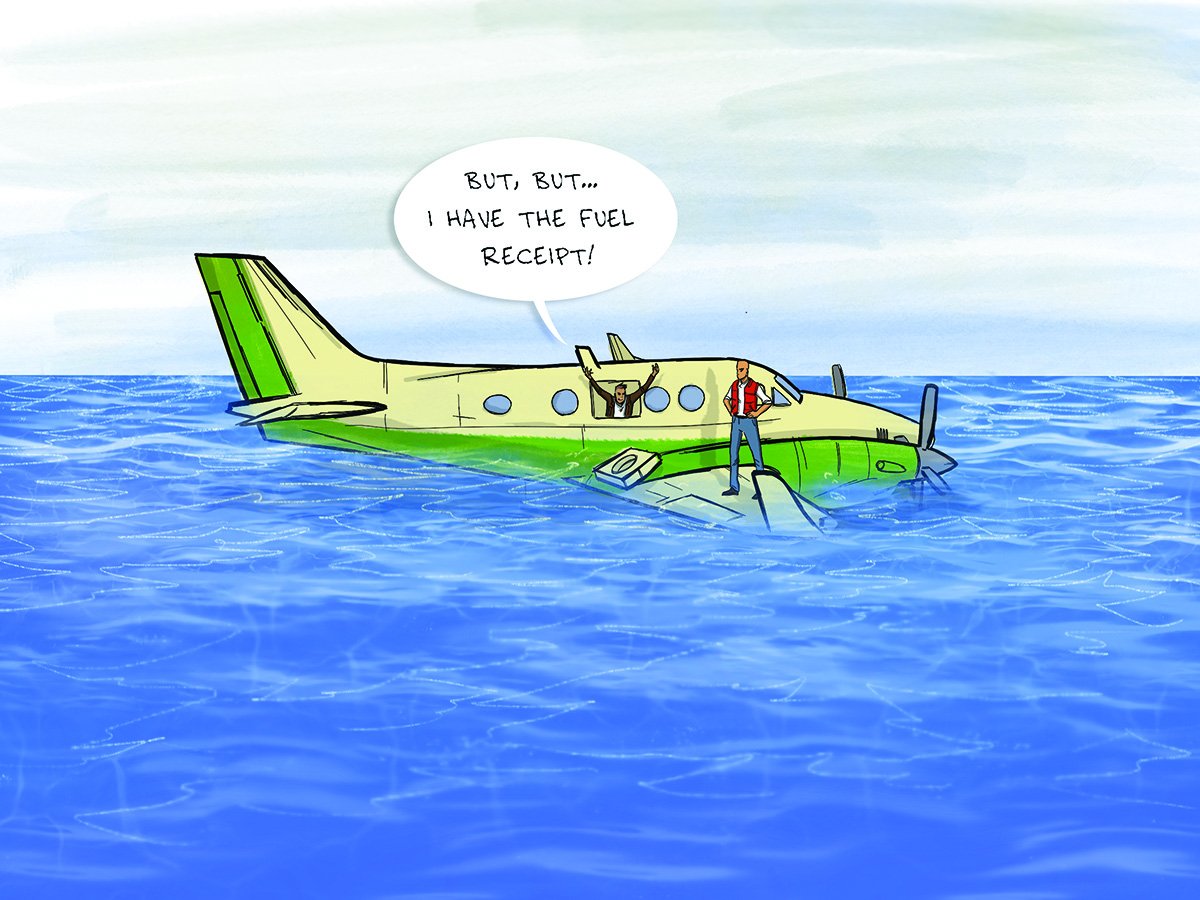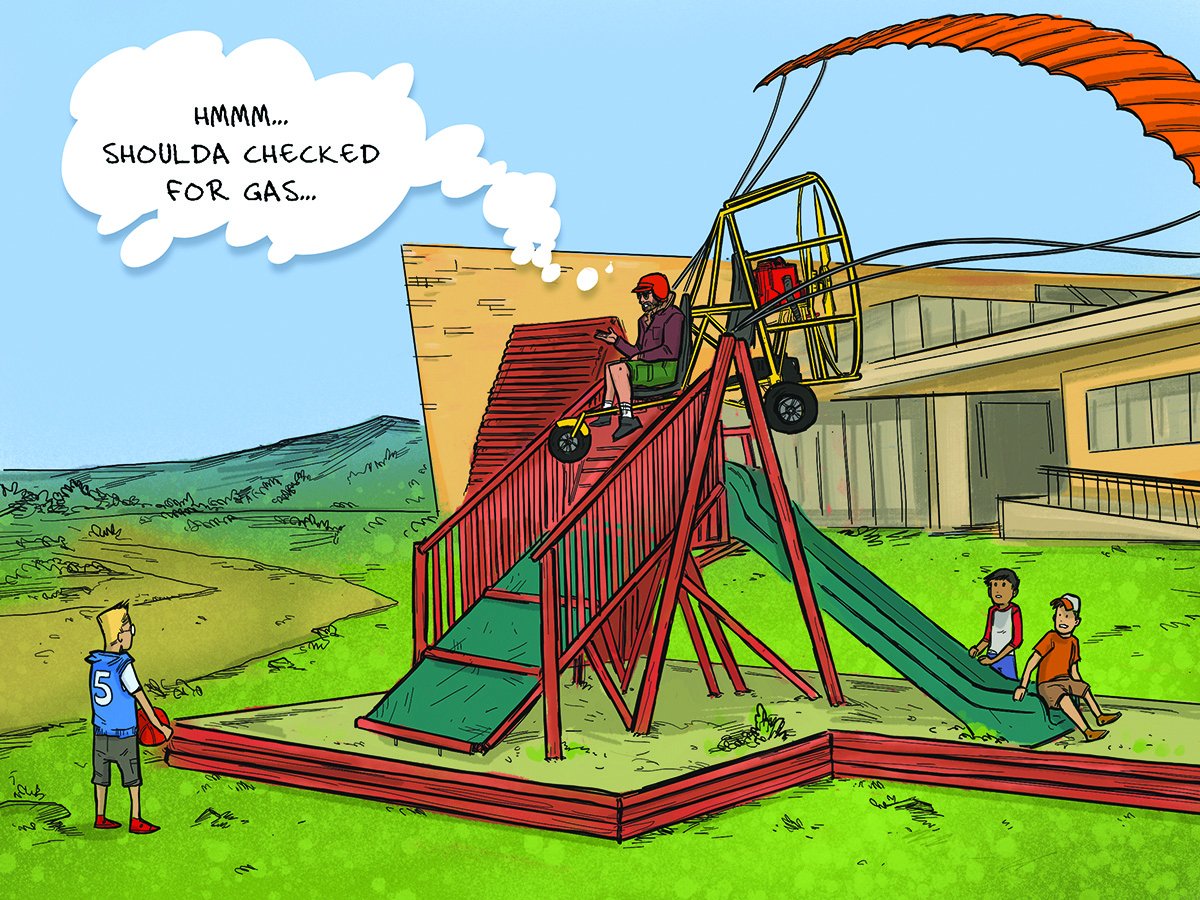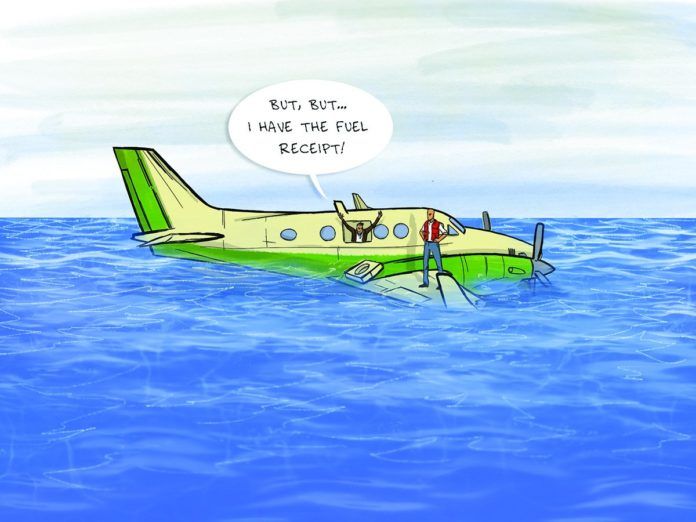Each year we pause in the quest for aviation excellence to examine those who’ve boldly gone where others with a mere dram of sense wouldn’t. This review covers 2012, the most recent year for which the NTSB offers probable cause to improbable silliness.
Only non-fatal events are covered because we assume it’s bad form to ridicule the dead. Contestants are limited to the USA, because, hell, we invented flight, even though France claims the naming rights. Plus, few other countries offer our freedom to fail.
Inability to fly is a common theme. Loss of directional control is as common as presidential candidates kissing Iowa hogs. Many victims attribute their misfortune to villainous wind gusts unverified by nearby sensors. Other popular maladies include: carburetor ice, inattention to density altitude, misjudging distance to runways and balloonists floating into, well, most anything not found in The Wizard of Oz. While stupidity is rampant in those categories, few met the exacting standards of ineptitude and perseverance this review demands.
It’s The Fuel, Stupid
Mismanaging fuel—as in managing to miss fueling—is a perennial favorite as pilots try to go the extra mile without the extra juice. Consider a California pilot who stretched the first mile with the left tank showing 1/4 full (3/4 empty?) and nothing—zero, zed, nada—in the right tank. He started, taxied and did the runup on the least empty tank before switching to the other tank for takeoff. For those taking notes, that would be the air-filled right tank. He survived the unplanned glider practice.
Not to be outdone, an Alaska pilot launched in a Maule but, skipping the checklist, didn’t set the fuel selector to the Oscar-November mode. Without fuel being ON, the engine transitioned to OFF shortly after rotation, bringing the Maule DOWN, damaging both fuel-filled wings. Inside a darkened NTSB confessional the pilot later opined that this “could have been prevented if he had used a preflight checklist.” Ya think?
Luckily a fuel-challenged pilot in a Beech Skipper in South Dakota had a non-pilot passenger who could interpret a low-fuel warning light. Averting a post-crash fire, the pilot circled the airport until every milliliter of usable fuel was gone. The NTSB got statements from the passenger plus a witness on the ground, but the pilot declined to file a report, perhaps assuming the passenger would handle that, too.
It’s a grand feeling to take delivery of a brand new King Air C90GTx at the factory in Wichita and fly it to the Caribbean. Even grander with enough fuel for the trip, which the pilots—yes, there were two—did. Almost. Stopping in Fort Lauderdale they headed for a night in a hotel after giving their fuel order to the FBO. As dawn broke over the misty Florida fjords, the two pilots returned. They split their duties, with one filing IFR while the other performed the preflight inspection.
Apparently it’s OK not to look into the fuel tanks if you have a fuel receipt. So off they flew, enjoying that new airplane smell. Leveling at FL270, someone noticed that the brand new fuel gauges read low. A quick check of the fuel receipt confirmed 134, which was plenty for the flight. This must’ve been vexing to the pilots as both engines quit for reasons unknown. The brand new King Air glided to a safe ditching, where it and its resale value sank into the tropical waters.
But they had 134 gallons. Upon closer inspection, the receipt showed that they requested only the nacelle tanks be topped off, which took just 25 gallons. The mysterious 134 turned out to be the fueler’s employee number, and, as we know, fuelers are servants blindly complying with customer requests.
Further north, a Wisconsin pilot made certain he was tanked up for an early morning departure in a Cessna 150. He’d wisely landed after cockpit lighting failed near sunset and chose to await dawn while refueling himself with a 12-pack of beer. This being Wisconsin that wasn’t a flag as a witness verified: “The pilot explained that he was going to drink beer and sleep until morning in the airplane.” Even a dozen beers only goes so far coaxing sleep inside a Cessna 150, so the pilot departed before dawn, unconcerned about the lack of cockpit or cerebral illumination. Neither improved, and the Cessna crashed to no one’s surprise.
Get Thee to a CFI
You’d think a flight instructor would limit stupidity. You’d be wrong, as many accidents involved CFIs reacting too slowly to student silliness.
Ben Bishop
Then there’s the Kentucky instructor whose student wouldn’t do anything dumb, so he intervened, setting the Cessna 172’s fuel selector to OFF within, he thought, gliding distance of the runway. Only the instructor was surprised the 172 didn’t reach the airport, and the CFI couldn’t restart the engine before crashing in a field. Not surprisingly, the CFI didn’t make instructor of the year for his realistic training technique.
Consider the Florida CFI in a Piper Arrow who was monitoring (key word) a CFI candidate performing a power-off approach to landing—a really hard landing as it turned out. KA-FWOMPH!
Stunned but undeterred, the future CFI and monitoring CFI, took off, tried to raise the gear but couldn’t and lowered it again. They then performed yet another power-off approach and called it quits but were unable to open the door. Help arrived to extricate the monitoring CFI and future CFI, who then marveled at the extensive wing damage.
In the post-accident interview the monitoring CFI said that during flight the future CFI was the “full manipulator of the controls” and to emphasize his lack of complicity, added, “I did not do anything.” He didn’t get instructor of the year either.
If an accident occurs and no one reports it, is it an accident? Apparently not in these cases beginning first in Florida where a rental Cessna 172 flew 91 hours on 77 training flights with, it’s assumed, 77 preflight inspections without anyone noticing the buckled firewall. Damage was only discovered when a mechanic actually looked at more than the oil dipstick during a 100-hour inspection.
And in Alaska, an air-taxi Cessna 206’s nose wheel hit hard in a bounced landing on a tidal beach. That hardly merits a shrug in Alaska, and perhaps it’s common to take off again, as the pilot did, and not mention the event to the mechanic who later spotted the substantial firewall damage.
Down Low and Stupid
They live and fly by different codes in the 49th state, and what might seem stupid in the lower 48 doesn’t move the needle in a place over twice the size of Texas. Consider the DeHavilland Beaver that nosed over in the Noatak River, 120 miles west of Bettles, wherever that is. The NTSB heard about the event—word spreads fast in Alaskan bars—and called the pilot, who reported that the nose-over occurred during taxi—not flight—so no need to get all federal about it.
The pilot claimed he’d landed safely on a gravel bar, parked for the night and returned in the morning, finding the mains and tail submerged by rising waters. He fired up the engine to taxi—not fly—it out. By his account, “the tires were lurching, and the tail was underwater.” The plot increased power to raise the tail from the water while applying “heavy braking action to control the airplane as he taxied downstream and downwind.” That’s when the airplane nosed over—while taxiing, not flying, so no accident. Or so the pilot claimed.

Ben Bishop
The National Park Service ranger who responded to the crash, took photos that supported, instead, the NTSB’s conclusion that the pilot had actually attempted to land on the gravel bar but undershot the touchdown and nosed over in the water. Further deflating the pilot’s story was the ranger’s statement that “the pilot asked him not to notify the NTSB or the FAA about the accident.” Tip: If you opt for the Don’t-Call-The-Feds dodge, make sure you’re not actually talking to one.
While vacationing in Alaska if you want to see bears from the sky, remember to fly the airplane while looking. A Citabria pilot was at 400 feet when he spotted two bears in a swamp and found that so intriguing—since bears are apparently rare in Alaska—that he circled for a better view but promptly stalled and crashed. Although the pilot walked away uninjured, the bears remained unimpressed.
Ag pilots make their livings down low and routinely bump into fences, trees and wires. But a spray pilot in Nebraska shot himself down when he reversed course after the first pass on a field and dropped “a little too low” only to encounter his own wake turbulence, tossing him into the corn.
Another Nebraska ag pilot wasn’t spraying but was heading home. At cruise above the trees, he adjusted the engine controls as usual, except the engine quit and into the corn he went. It seems the airplane recently had an engine conversion, with a new throttle quadrant putting the mixture where the propeller knob had been. You know the rest. Probable cause: Yeah, corn.
Many antique airplanes lack electrical systems so are routinely started by hand. It’s fun and safe, you know, like juggling chainsaws. Electric starters debuted on more modern engines, because Darwinian selection was causing too many pilots to be nicknamed Stubby. Despite these technological advances, batteries die, and strong-armed pilots can’t resist the chance to spin the prop by hand and save the flight, often with no experience in the subject.
Picture the Ercoupe pilot in Washington taking a passenger for her first ride only to discover that the battery was dead. “Oh no,” you’re thinking. “Not the old the-battery’s-dead-and-we-have-to spend-the night-in the-pilots-lounge routine!” Not at all.
The pilot elected to hand prop the engine. He had so much faith in the brake that he elected not to chock the wheels or tie down the tail. The engine started easily, but RPMs ran higher than expected, and the parking brake held less so. Off the Ercoupe rolled with the non-pilot passenger attempting the basics of steering as the pilot vainly attempted to reenter the cockpit, leaving his passenger to taxi through a fence, over an embankment and, we assume, out of the pilot’s life forever.
And The Winners (Losers?) Are:
With pilot friends like this, who needs Comedy Central? The pilot of an experimental RV-6 in Michigan told a friend to get to the beach and watch for his flyby. As promised the sleek two-seater buzzed at 100 feet, made three passes—one is never enough—pulled up in a steep turn, stalled and hit the water, securing the 2012 Bronze Stupid Pilot Tricks Award.
Earning silver with a display of star-spangled patriotism was the helicopter pilot who on July 4th attached a flag to the skid of his experimental Rotorway and lifted it so all could see, but O, say could they see the flag rip lose, entangle itself in the tail rotor and bring Old Glory to an inglorious end.
Taking home the gold was the non-certificated “pilot” in Georgia who’d recently purchased a Destiny XLT powered parachute—picture a swamp buggy with a canopy—and tried to impress his neighbors with his ability to learn on the fly. Spectators in the cul-de-sac watched the “pilot” unpack the chute, start the engine and begin the takeoff roll. It was then, this non-certificated “pilot” aborted the flight, concerned that he might hit nearby houses.
This sort of responsible aeronautical decision-making gets you lost to history, so our hero loaded his Destiny onto a trailer and relocated to a nearby elementary school to re-enter the competition. He was back in contention.
After unpacking the rig, the “pilot” took the front seat, started the engine and flew. Once airborne, he decided it wise to fasten the seatbelt while making two circuits of the elementary schoolyard. It was then that he realized he’d never checked to see if there was any fuel in the tank. There was, but not much. The engine quit, and the non-certificated “pilot” glided into phone lines and crashed.
For persistence in stupidity, with added points for choosing an elementary school venue for displaying said deeds, we present the coveted Stupid Pilot Tricks Knucklehead Award for 2012. Although the FAA was powerless to take action against the certificate the “pilot” did not possess, it did revoke his playground privileges for a month.
Paul Berge, former editor of IFR, now prefers taildraggers and VFR in Iowa as he teaches, writes, films and entertains.





